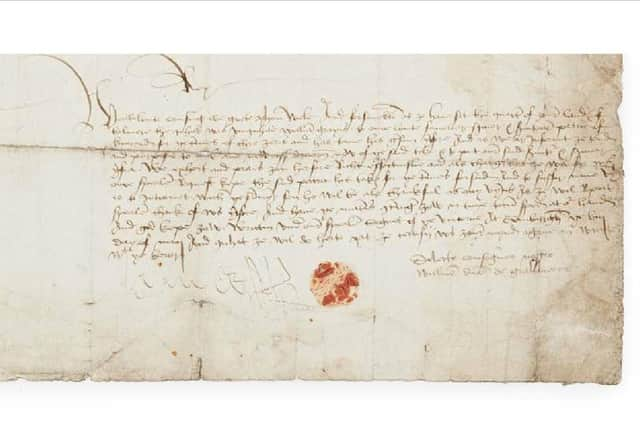500-year-old letter written by James IV, complete with red wax and damp stains, comes up for auction
The letter, complete with signature, traces of a red wax seal, damp stains and old folds, is expected to fetch up to £1,500 when it goes under the hammer at Lyon and Turnbull this week.
The correspondence was sent by James IV to William Graham, 1st Earl of Montrose, who was earlier granted substantial lands by the King in return for his support.
Advertisement
Hide AdAdvertisement
Hide AdOn May 8, 1500, the King wrote to Graham with a request that “our most lovit familiar squier & servitour Patric of Kincaid” was permitted to extend a lease on land at Balmore, Stirlingshire.
Graham was an influential ally of the King and sat in James IV's first parliament on October 6, 1488, subsequently receiving grants of lands at Aberuthven and Inchbrakie in Perthshire.
Following the 1503 marriage of James IV to Margaret Tudor, the sister of Henry VIII, an earldom was created for Graham out of the Lindsay dukedom of Montrose, which had lapsed to the Crown on the death of David Lindsay, whose family had destabilised Angus.


Both James IV and the Earl of Montrose died on the field at the Battle of Flodden in 1513, which was fought after James IV, in a bid to protect the Auld Alliance, declared war on England after Henry VIII invaded France.
Dominic Somerville-Brown, Lyon & Turnbull books and manuscripts specialist, said: “We will never be able to reconstruct a picture of what James IV was like. Almost the best we can do is use documentation like this to see how he functioned during his time.
“James IV is writing to a very powerful supporter and it brings to life what power involved in Scotland and society more generally at that time, and that was land ownership.
“There is a case to be made that kings back then were like first among equals more than these semi-divine figures. The king was generally as much part of the feudal system as these earls and barons. So they were kings and they did have overall authority, but they were still constrained by the nature of the society they lived in."
Comments
Want to join the conversation? Please or to comment on this article.
